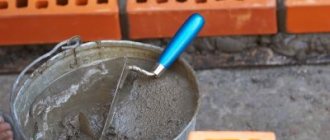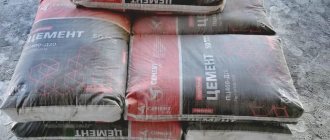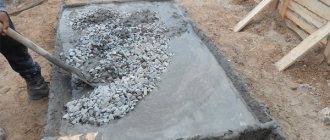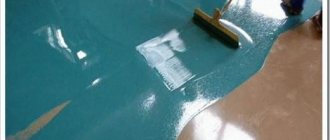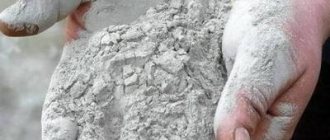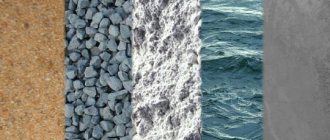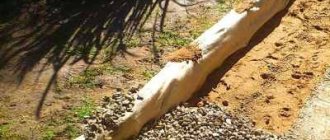A picture familiar to many: after construction or renovation, cement remains, which over time has become unusable. It has lost its quality and original properties, but with some effort, it can be used where there will not be heavy loads on the material.
A picture familiar to many: after construction or renovation, cement remains, which over time has become unusable. The illustration for the article is used under the standard license ©dachnyedela.ru
How to store cement in bags in winter and summer
The main rule of storage is compliance with humidity standards, and this is not only about maintaining certain conditions indoors, but also about choosing the right place to place the material outdoors.
If you decide to store the mixture indoors, be sure to eliminate all drafts and check how efficiently the ventilation system works. It is these two factors that will most influence air humidity. In winter, it is extremely important to prevent the walls from freezing, and in summer it is important to regularly ventilate the room. Now let's talk about how to store cement outside
. If you are forced to keep the mixture outdoors, try, firstly, to use it up or move it indoors as quickly as possible, and secondly, make a special pallet from wooden boards, place bags on it and cover them with a tarp. This will at least partially protect the mixture from the harmful effects of moisture. In winter, the composition must be wrapped not only with a tarpaulin, but also with a film that will prevent it from freezing; In summer you can get by with a single layer of coating.
Following another important rule for storing the mixture will help you maintain its composition. If cement is placed in original packaging, it is extremely important not to damage its integrity, since the bags are made of kraft paper and polyethylene - materials that do not allow moisture to pass through. Therefore, immediately after delivery of the shipment, carefully inspect each bag; If the packaging is damaged and it is not possible to replace it, additionally wrap the bag with a tarpaulin. Remember that even if all storage rules are followed, the quality of the mixture will deteriorate by about 15% every month, so try to use up the cement as soon as possible after purchase.
Storage period and conditions
Cement has a short shelf life. Therefore, purchasing “in reserve” is not recommended. After 2-3 months of storage, it loses up to 15% of its safety margin, and after six months the figure drops to 50%.
This is explained by the fact that the material tends to absorb moisture from the environment.
As a result of exposure to moisture and carbon dioxide, a chemical reaction of hydration occurs. The material's chemical structure changes and it hardens.
According to factory requirements, it must be stored in dry warehouses, on wooden or plastic pallets, in stacks up to 2 meters high.
Subject to these conditions, the shelf life from the moment of shipment from the factory should not exceed 60 days.
During long-term transportation and violation of storage conditions in warehouses, there is a possibility that material that has already lost its basic properties will end up in hardware stores.
You can extend the shelf life by packing paper bags in plastic. Hermetically sealed bags are stored in such conditions for up to 1 year.
You can also use an alternative storage method: pour the material into a sealed plastic or metal container, close tightly and wrap it with film. Cement stored in this way can retain its properties for up to 1.5 years.
Cement has a short shelf life. The illustration for the article is used under the standard license ©dachnyedela.ru
How to properly store exposed cement
Regardless of what type of mixture you purchased, you cannot store it without packaging, as the mixture will lose its properties. For a short period (1–2 days), you can keep the dry composition without packaging. To do this, it is poured into a wooden pallet and covered with a tarpaulin; this time should be used to pack the mixture. If it is not possible to purchase kraft paper bags, then take regular paper and plastic ones and package the dry composition in them. When placing the mixture in bags, do not try to place as much of the mixture as possible in one package. Also, do not leave significant air gaps; everything needs moderation.
Remember that it is extremely important to pack the mixture carefully: the less contact with air, the better. Next, wrap the resulting bags with a layer of polyethylene, which will serve as additional protection. We do everything else (placing it indoors or on a pallet) by analogy with the mixture in the original packaging. In order to preserve the composition for as long as possible, try to pour it into new bags at least once every 1-2 months, this way you will prevent caking and reduce the likelihood of spoilage.
Of course, it is unreasonable to store cement for a long time without its original packaging, it will simply lose its properties, but you will ensure the safety of the composition for 3-4 months if you follow all the recommendations given above. Experts do not advise purchasing dry cement mixtures for long-term storage, since not everyone can provide the right conditions, and the risk that the composition will simply have to be thrown away due to violation of the rules for storing it and spoilage increases.
Is it possible to use cement that has hardened in a bag?
Cement is the most important component of concrete and building mixtures. Not a single construction project can be done without it, except in cases where truck mixers are used, and builders use imported ready-mixed concrete and masonry mortar.
However, it often happens that the designer incorrectly calculated the required amount of cement. They brought it several bags more than required. But these bags remained out of use.
Meanwhile, the shelf life of cement in a bag is only 2 months. If you don't use it on time, it will harden right in the bag and cake.
And this is not the whole truth! Many manufacturers are interested in the rapid unusability of cement because they wrap it in paper bags. The more cement deteriorates, the more it will have to be bought (on the buyer's side) or sold and receive additional profit (on the seller's side). For example, if cement were wrapped in ultra-dense plastic bags, its shelf life would increase at least three times.
Just think about building mixtures, like plaster or putty. The dry composition is stored in plastic bags with a film liner, so their shelf life is never less than 6 months.
But the bag of cement has been lying idle for six months. The cement inside hardened and became covered with a dense crust. Can it be used in construction? And if there are five of these bags, how not to lose the money spent on them?
You can use hardened cement. However, the scope of its application is significantly reduced. It is best to use it for concreting pillars or architectural structures that are not subject to large mechanical loads.
At the same time, the strength properties of cement are no longer the same as when purchased. For example, cement grade M-400 will in reality correspond in strength to cement grade M-200 or M-300. It all depends on how long he lay there.
How to make hardened cement crumbly again? To do this, place the bag on its edge so that the cement crumbles inside the bag under its own weight. After this, place the bag on the other edge and wait until the cement crumbles. Roll the bag on the floor in one direction or the other until the contents reach the desired consistency.
This does not mean that the cement will again become as crumbly as it was when purchased. Lumps in its thickness will still remain, and their size and quantity again depend on how long the bag has been in the warehouse.
How to save on cement and concrete
Concrete mortar is one of the most basic and most popular building materials. And it’s no secret that the price of its components, primarily cement, is not too low, although this product, apparently, is not in danger of a sharp increase in cost. For those who build slowly, slowly and on a small scale, cement costs even more, because there is no “retail” delivery in our country: either carry a bag of cement on your own back, or order expensive transportation.
However, there is an opportunity to save a little.
This applies primarily to blind areas, concrete paths, and the entire concrete surface of the site. You can put a layer of bricks under it. They are laid without any solution or using a small amount of it. A layer of concrete mortar is applied on top of this brick covering; thus, it will be required significantly less than with the traditional pouring method. In some cases, a layer of mortar may not be applied at all, leaving a brick path. This technique is used, for example, when creating a “rustic” style of site design.
In addition to bricks, other objects can be placed under the path. For example, glass or plastic bottles. Plastic ones are pre-filled with earth to give them rigidity.
Recently, bottles have increasingly become a “common” building material , from which they even build houses. In Thailand, even a Buddhist temple was built from glass beer bottles. In a more “down-to-earth” version, bottles become part of borders, decorative fences and fences. We often saw “bottle-concrete” fences among neighbors, friends and acquaintances.
First of all, bottles are used in them for reasons of economy, but some manage to create an interesting design style on this basis. Bottles in construction are one of the signs of post-industrial society. However, Russians lag far behind “prosperous Europe” in terms of the use of bottles and other waste materials in construction and design, and the main reason for this is the stereotypes ingrained in people’s minds. Meanwhile, in a technological sense, bottles are in many ways not behind, and in some ways superior to “traditional” building materials, and in terms of monetary costs they can save a lot. Let's hope that in the future Russians will fully appreciate the benefits of “non-traditional” construction.
For decorative fencing, you can also use the so-called dry masonry. The stones here are stacked on top of each other without any binding material. The old masters used special methods of laying stones, thanks to which the building (and it could be a utility or living space, even a huge tomb or temple) did not fall apart even during an earthquake. Such methods, as a rule, are not familiar to ordinary summer residents, and for dry masonry they must use fairly heavy flat stones.
Concrete paths around the house are created, in particular, in order to get rid of lush weeds, which are very difficult to combat. However, some designers use the natural vegetation on the site for their own purposes, without completely covering it with concrete, but by combining areas with and without covering. Of course, grass in areas without cover requires regular maintenance, otherwise it will turn from a design element into a nuisance.
Can I use old cement?
As you know, cement loses its properties over time, and, alas, this happens quite quickly. Wet or damp cement deteriorates immediately, but cement that is stored in more or less optimal conditions ages gradually. If you have a bag of not very “outdated” cement, then it can be used in “major” work if you add an increased dose to the solution. The fact that cement is aging can be checked by touch - the powder becomes denser and heavier, and produces less dust.
If the cement is even more expired, then it will no longer be suitable for a full coating. But you can use it as a preliminary coating. On the layer of mortar with old cement, another one with fresh cement is placed. In this case, it is advisable to take the strengthening of the building more seriously - create reinforcement , use special additives that increase moisture and frost resistance. Petrified cement, of course, is no longer good for anything... almost. It can be used, for example, as a material for garden or garden paths, which are arranged mainly for decorative and “cosmetic” purposes. Residents of the outback came up with another purpose for old cement. In the provinces, there is often no asphalt on the streets, and the dirt road is full of holes, potholes, and uneven spots. All of them are filled with petrified cement mixed with gravel, brick chips, and sand. This “filler” lasts quite a long time, making it easier for vehicles to travel through.
As we can see, if an accident happens and the stored bag of cement goes bad, you shouldn’t rush it
throw it away, since it will still be useful, if not in the main construction work, then in additional ones - finishing, filling gaps, creating a temporary covering, etc.
In conclusion, let us recall that cement as such was discovered relatively recently - only in the 19th century, but concrete has existed since time immemorial. Ancient peoples used lime , as well as rubble (ground into powder) stone, and shards of pottery. Modern scientists have restored this ancient concrete and noted that it has quite high strength.
Despite the fact that it was already actively used in the countries of the Ancient East (Sumer, Babylon) several thousand years BC, in the history of technology it is known as “Roman concrete” - after all, with its use, the buildings of ancient Rome, classic for European culture, were built . So if suddenly for some reason you can’t get cement, you can try this ancient option - everything is better than nothing at all.
Can caked cement still be used?
IMHODom › Forums › walls and structures › Can caked cement still be used?
- This topic has 19 replies, 17 voices, and was last updated 8 months, 1 week ago by DED.
- Stepanovka
There are several bags of cement left over from the winter - now it is not in powder form, but in pebbles.
I can always throw it away, but can I use it? For example, adding it to mortars with fresh cement - or will it only make things worse?
I think it’s better to throw it out so as not to spoil the statistics...
If you grind it again, it will be 80% of the original grade. Do not throw lumps into solutions!
It is necessary to wrap the remaining cement tightly in film for the winter. Helps a lot for safety. And in the spring, look at the hardness of the lumps. Using a small sledgehammer (head down), calmly hammer and grind like a masher. If it doesn't work, throw it away. I always did this with the remaining cement. Naturally, a certain remortgage is needed.
And one more thing - when using concrete made from compacted cement, it takes much longer to gain strength. It can even be misleading - in a week you will think that nothing worked, but in the end it will grab as it should.
A week. Concrete “lives” for 4 hours! Well, let it be 6 hours on bad cement. But not for a week. You need to pour less water.
Let's say the maximum strength of concrete is 100%. After pouring, after 12 hours it will be approximately 10%. You can already walk from above. To reach maximum strength, you need to either wait 28 days for it to pass, or keep it in a steaming chamber for 2-3 days. Probably for compacted cement, the maximum that can be achieved in terms of strength is 75-80% compared to fresh cement. The time to reach the maximum should also, in theory, increase by about 20-40%. those. 35-40 days.
It is best to use this cement to improve the road...
When installing paving slabs, it is recommended to mix sand and cement 10 to 1. Sprinkle the same mixture on top of the tiles and sweep them so that the cracks become clogged. After laying the tiles, water them with a hose. This is exactly how I want to use my compacted 10 bags...
Light a fire, put a sheet of iron and cement on top, and it will be as it should again
- Tomsk region
Light a fire, put a sheet of iron and cement on top, and it will be as it should again
Did you check it later in the laboratory?
And so a little for reference on the posts above. The survivability of concrete and mortars, I emphasize ordinary ones, cannot last for several hours. After preparing the concrete or mortar, as soon as you leave it alone, after 40 minutes, provided that the ambient temperature is above 15 degrees, the setting process begins. Once it starts, you can’t touch the solutions; the strength will suffer greatly.
Light a fire, put a sheet of iron and cement on top, and it will be as it should again
Did you check it later in the laboratory?
And so a little for reference on the posts above. The survivability of concrete and mortars, I emphasize ordinary ones, cannot last for several hours. After preparing the concrete or mortar, as soon as you leave it alone, after 40 minutes, provided that the ambient temperature is above 15 degrees, the setting process begins. Once it starts, you can’t touch the solutions; the strength will suffer greatly.
Theoretically, cement is prepared by firing, apparently reengineering is proposed. But practically, I think, the quality of the reconstituted cement will be below criticism.
But how can you remember an everyday trick?
- Tomsk region
But how can you remember an everyday trick?
The most common designations for cement
- PC is ordinary Portland cement.
- ShPC is Portland slag cement containing more than 20% additive compared to the clinker component.
- BC – white cement for finishing.
- WRC is a waterproof expanding cement. Used for sealing seams in hydraulic structures. Characterized by fast setting (4-10 minutes).
- N – standardized cement. Contains clinker of strictly standardized composition.
- PL – plasticized cement with high frost resistance.
- GF – hydrophobic cement. It does not absorb water within 5 minutes, is easy to transport, and is characterized by good plasticity and frost resistance.
- SS – sulfate-resistant cement. It is used for the construction of hydraulic structures in aggressive water-salt environments containing sulfate compounds.
- B – fast-hardening cement. Used for urgent repairs.
What to do if the composition in the bag has hardened
If the cement has hardened, do not rush to mix a solution from it. First you need to understand whether it will be suitable for preparing concrete, whether its use will affect the strength, reliability, and durability of the element, structure, or building.
Why does cement harden?
Cement hardens mainly due to moisture entering the powder. After all, the main condition for setting and hardening of cement is the passage of a chemical hydration reaction. Water and cement interact, form crystal hydrates, then go through two stages: setting and hardening of the mixture. Spatial connections are formed between the elements, after the destruction of which the cement will no longer return to its original form.



